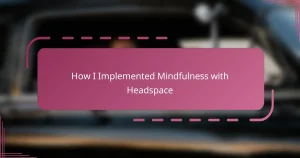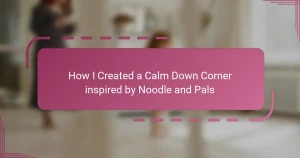Key takeaways
- Timeouts can serve as emotional resets for both parents and children, promoting calmness and self-regulation rather than punishment.
- Consistency in timeout practices, including clear rules and a dedicated calming space, fosters trust and understanding in the parent-child relationship.
- Involving children in the timeout process by explaining its purpose turns it into a learning opportunity, enhancing their self-control.
- The parent’s calm demeanor during timeout significantly influences the effectiveness of the approach, making it a moment of growth instead of conflict.
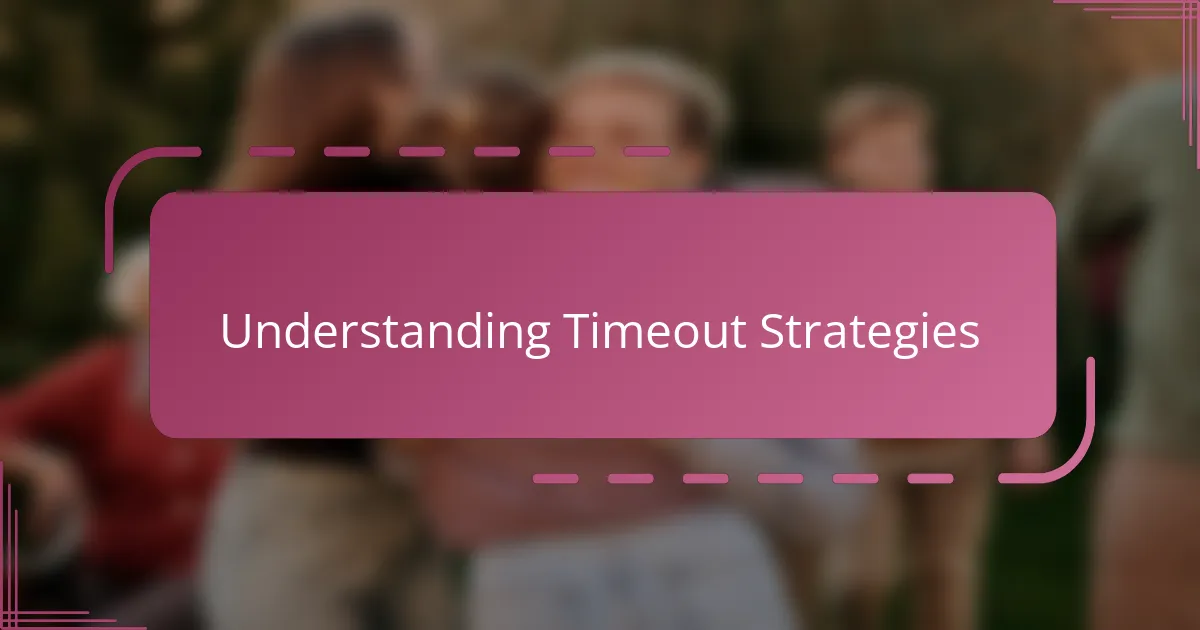
Understanding Timeout Strategies
Timeout strategies, to me, have always been about more than just a pause in behavior—they’re moments for both child and parent to reset emotionally. Have you noticed how a brief timeout can sometimes calm the storm inside your child’s mind? I found that understanding this made those tough minutes feel less like punishment and more like a quiet chance to regroup.
In my experience, the real value of timeout lies in its simplicity and clarity. When I started seeing it not as a way to shame but as a natural consequence, it changed the entire dynamic at home. It became a tool of teaching, gently guiding my child toward better choices without the drama.
I often wonder, why do we rush to fill every second with distraction or discipline? Timeout offers a pause—an opportunity to teach patience and self-control, lessons that are sometimes hard to grasp in the heat of the moment. Recognizing this shifted the way I approach discipline; it’s about growth, not blame.
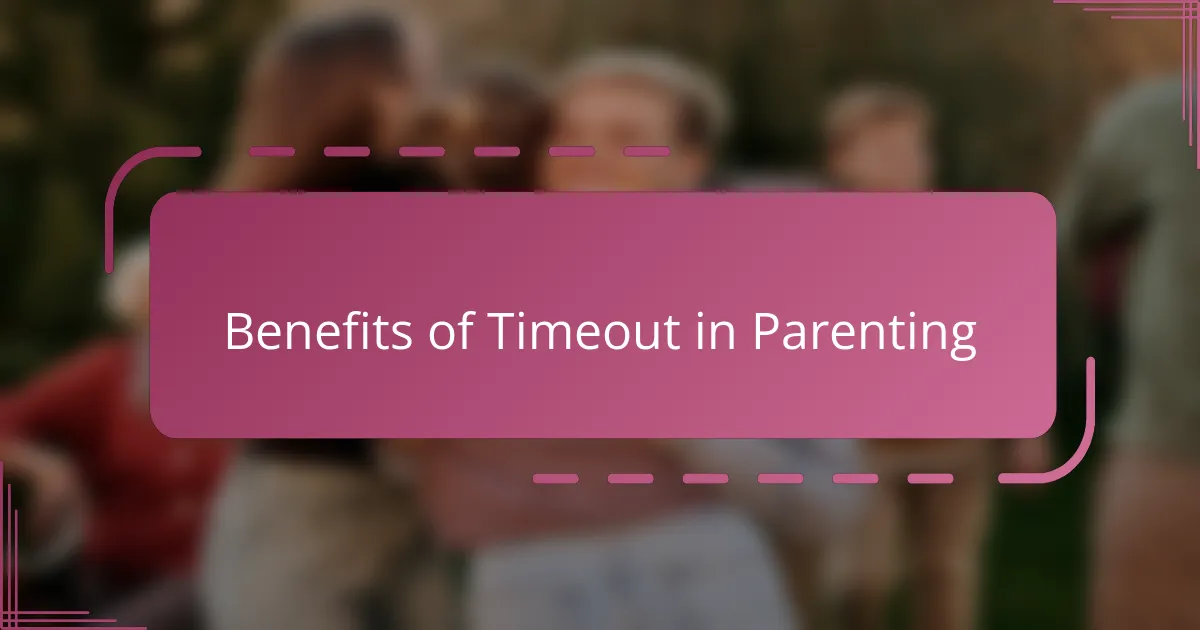
Benefits of Timeout in Parenting
One of the biggest benefits I discovered with timeouts is how they create a calm space for my child—and for me. When emotions run high, stepping back for a moment helps us both breathe and think clearly. Have you ever noticed how a simple pause can reduce the frustration that otherwise spirals out of control? I certainly have, and that calm moment often leads to better conversations afterward.
Timeouts also gave me a chance to teach my child about self-regulation without raising my voice. Instead of reacting impulsively, I learned to use those quiet moments to model patience and understanding. It’s amazing how children can pick up on these subtle lessons when we give them the chance to reset.
What surprised me most was how timeout moments built trust rather than resentment. When my child knew that timeouts weren’t punishments but chances to regroup, they started to accept them without fear. That shift made our relationship stronger and discipline more effective—and isn’t that what every parent hopes for?
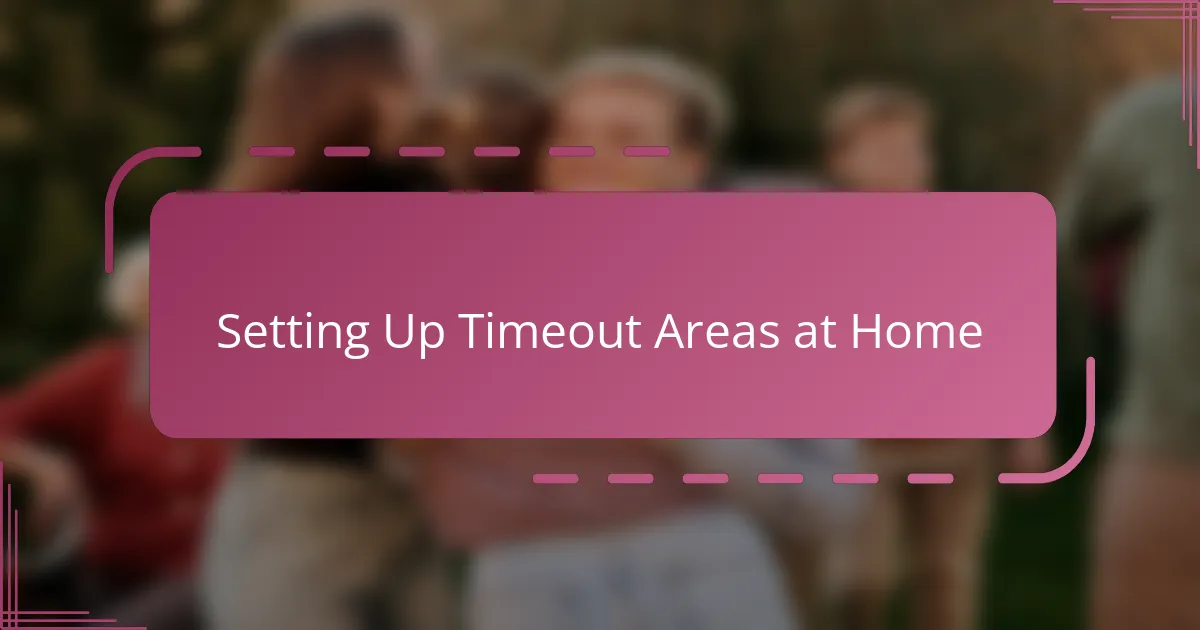
Setting Up Timeout Areas at Home
Creating a specific timeout area in our home was a game changer for me. Instead of feeling like a corner or a place of isolation, I made it cozy and inviting—just a small chair with a few calming toys nearby. Have you ever noticed how the environment can influence emotions? That simple, consistent spot became a beacon of calm rather than a place of dread.
I also found that keeping the timeout area free from distractions made all the difference. No screens, no toys that excite too much—just a quiet space that signals a break from the chaos. It took a bit of trial and error to find the right balance, but having a dedicated spot helped my child understand clearly, “This is a time to pause and think.”
Sometimes I catch myself wondering if the timeout corner should be more like a sanctuary or a boundary. For us, it became both. Making that distinction in the setup helped me stay consistent, and my child began to see it not as a punishment but as a helpful reset button—a place to catch their breath and come back calmer. Do you have a special spot in your home that feels like a timeout haven? If not, maybe it’s worth creating one.
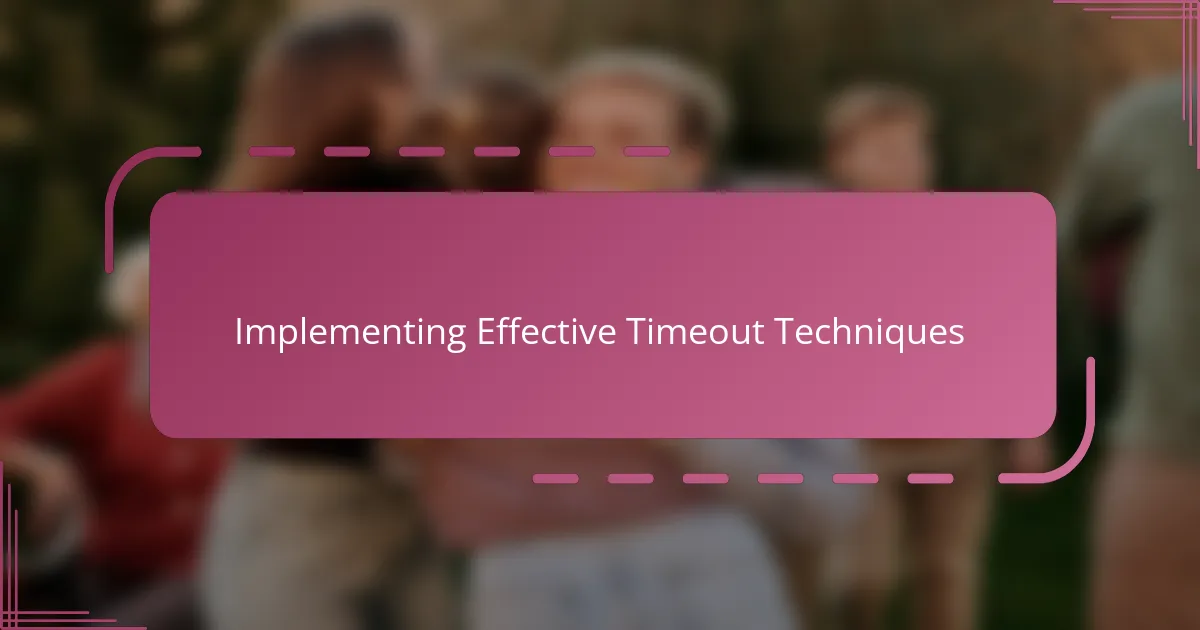
Implementing Effective Timeout Techniques
When I first started using timeout techniques, I quickly realized that the key was consistency. If I wasn’t firm yet gentle about the rules—how long the timeout would last and what behavior actually led there—it confused my child and weakened the whole process. Have you ever found yourself wavering on timing or expectations? Setting clear, predictable boundaries made those moments less stressful for both of us.
Another detail that made a big difference was involving my child in the timeout routine. Instead of just sending them away, I explained why the timeout was happening and what they could do next time to avoid it. This simple conversation transformed timeout from a punishment into a learning opportunity, which I believe helped my child develop better self-control over time.
I also noticed that my own attitude during timeout mattered a lot. When I stayed calm and patient, my child mirrored that energy and it softened the moment. But on days when I felt frustrated or rushed, the timeout felt more like a power struggle than a helpful pause. Does your mood affect your approach? Being mindful about staying composed is something I’m still working on, but it truly changes the whole dynamic.
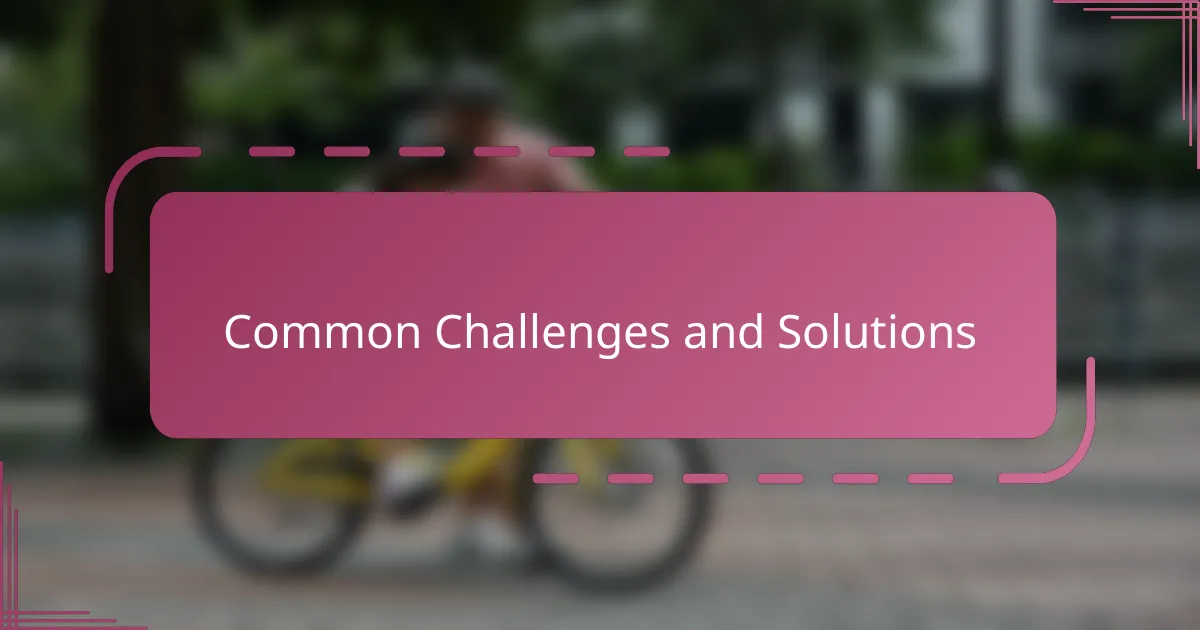
Common Challenges and Solutions
One challenge I often faced was my child resisting the timeout, turning it into a battle of wills. Have you ever felt that frustration when a simple pause spirals into a tantrum? What helped me was staying calm and sticking to the routine—over time, the resistance faded as my child understood the timeout wasn’t a punishment but a chance to reset.
Another tricky part was knowing how long a timeout should last. Initially, I would extend it too long, thinking more time meant better results, but that just made my child feel isolated and upset. I learned that keeping it brief and consistent worked best—usually one minute per year of age—and that clarity made those minutes more effective and less daunting.
Sometimes, I struggled with my own feelings during timeout moments, battling between patience and impatience. Have you noticed how your mood can influence your child’s response? When I reminded myself that timeout was about teaching, not punishing, it became easier to stay composed, turning those challenging episodes into meaningful growth for both of us.
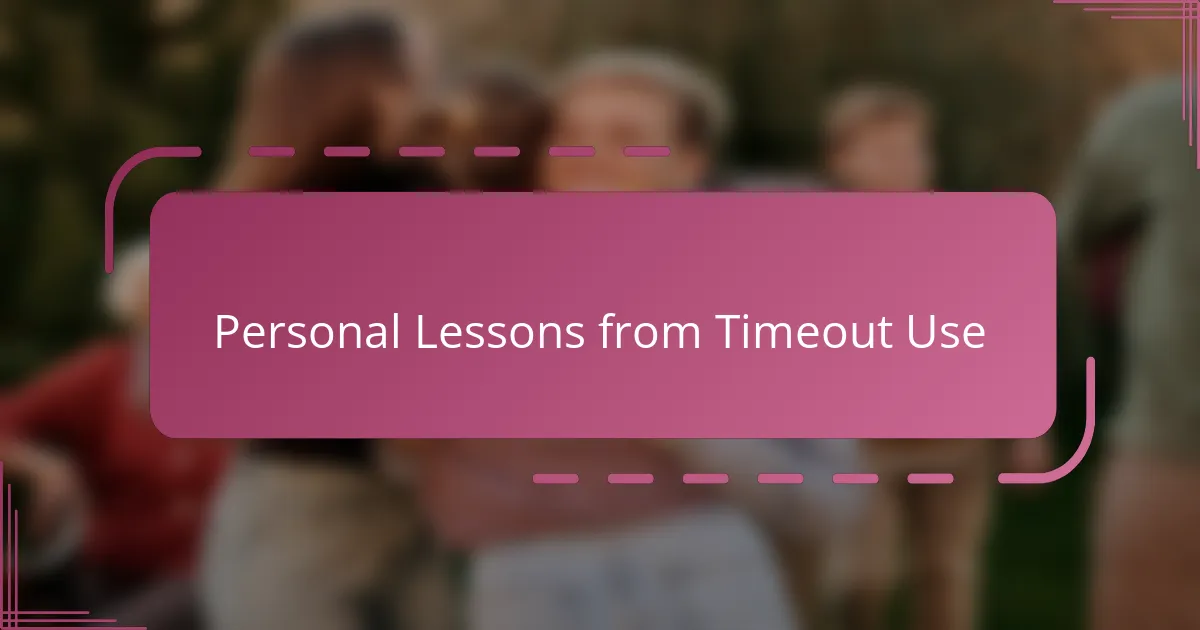
Personal Lessons from Timeout Use
Timeouts taught me that patience truly is a muscle—it had to be exercised regularly to grow stronger. Early on, I struggled with feeling guilty, thinking I was being too harsh, but I realized that timeouts weren’t about punishment; they were about guiding my child gently toward understanding their emotions. Have you ever felt conflicted about discipline? That tension eased once I saw timeout as a moment of compassion, not conflict.
I also learned that consistency was more than just a rule—it was the foundation of trust. When my child anticipated what would happen, the timeout lost its sting and became a predictable break rather than a scary consequence. This shift surprised me; it made me wonder, why does predictability comfort children so much? For us, it meant fewer battles and more cooperation, which felt like a big win.
What resonated most deeply was seeing timeout as a chance for connection rather than separation. During those quiet moments, I sometimes whispered reminders that I loved my child and believed in their ability to do better. That small gesture helped transform timeout from a cold reprimand into a warm, shared experience—a personal lesson I’ll carry in all aspects of parenting.
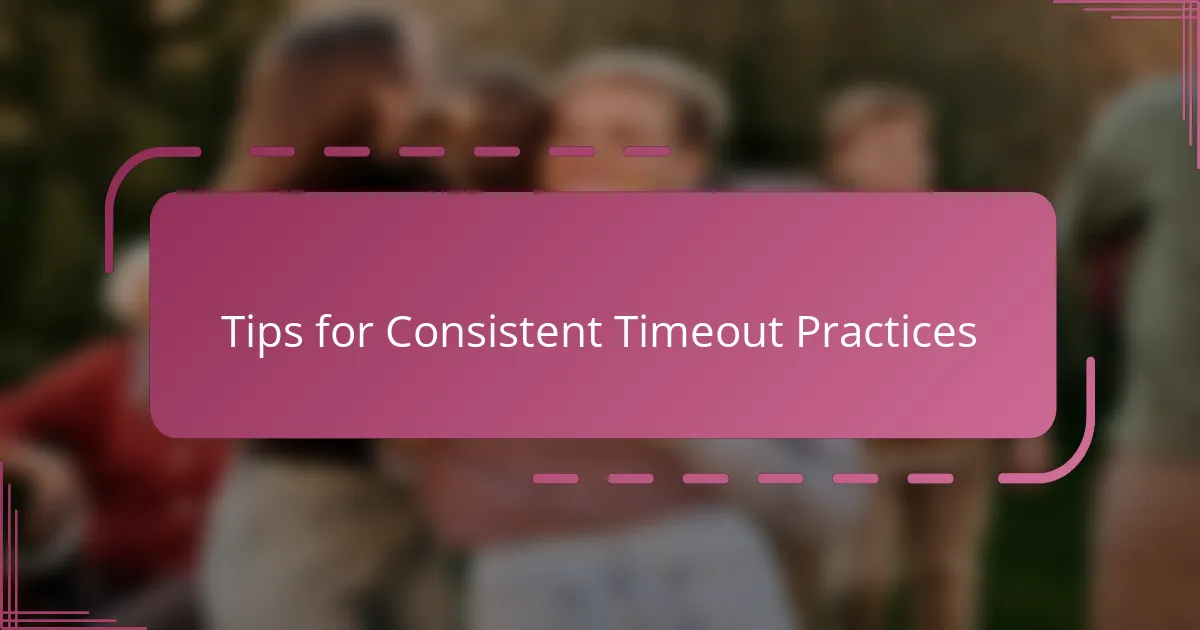
Tips for Consistent Timeout Practices
Sticking to a consistent timeout routine made all the difference in my home. I found myself asking, how can my child learn if the rules change from day to day? Setting clear expectations—like the exact length of the timeout and what behaviors would lead there—gave us both a sense of stability that reduced confusion and resistance.
I also realized that my tone during timeout mattered just as much as the timing. When I spoke calmly and stayed patient, even if inside I felt frustrated, the whole experience became smoother. Have you noticed how your own mood can either escalate or ease the situation? This awareness helped me turn timeouts into moments of learning rather than power struggles.
One trick that worked surprisingly well was involving my child in the timeout process. Beforehand, I’d explain why the timeout was needed and what they could try next time—transforming the pause from punishment into a chance to reflect. It made me wonder, doesn’t that conversation plant a seed for better choices? For me, it definitely nurtured more understanding and cooperation over time.
